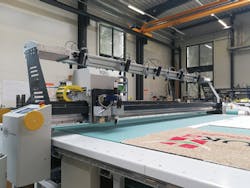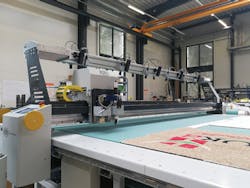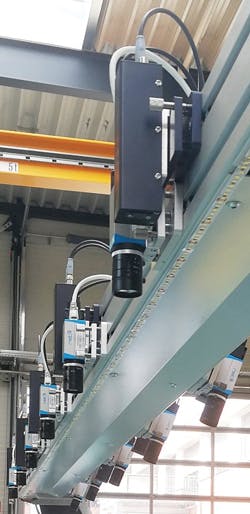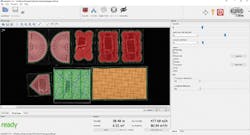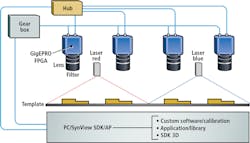3D Imaging: Embedded FPGA processing engine tackles 3D web inspection
Automation solution provider digMAR (Kramsach, Austria; www.digmar.at) has developed a 3D image processing system for carpet and textile cutting machine provider KURIS (Deggingen-Reichenbach, Germany; www.kuris.de). The multi-camera machine vision system is designed to scan textile materials so that optimal cutting coordinates based on height characteristics of the material can be automatically calculated in order to guide and control cutting equipment.
With more than 10,000 installations across the world, KURIS offers a comprehensive line of equipment in the field of material spreading and cutting technology to the textile and automotive industries. When KURIS needed a scalable, customizable, 3D solution, they enlisted the services of digMAR because of its in-depth experience in the development of software and systems with a focus on digital image processing.
laser triangulation for real-time quality control developed by digMAR.
Because inspecting extra-wide and fast-moving web materials such as this demands high-speed, high-throughput processing of large 3D data streams, engineers specified GigEPRO cameras from NET New Electronic Technology GmbH (Finning, Germany; www.net-gmbh.com). Dubbed the "open camera concept" by the smart camera manufacturer, the design combines a standard GigE Vision camera with an open FPGA processing engine.
This architecture allows the execution of standard or custom algorithms on the camera-integrated FPGA, which offloads the PC of computationally-intensive tasks. The result is a significant reduction in the amount of data being transferred from the camera to the PC for processing, and, in this particular application, real-time execution of 3D laser triangulation algorithms on the camera itself.
"Understanding the demanding requirements of the application, and the fact that KURIS could not compromise on the quality of its optical control systems because they have significant impact on the production quality and processing speed of its customers, digMAR engineers quickly realized the benefits offered by GigEPRO cameras," notes Tim Miller, Industrial Sales Manager, NET New Electronic Technology.
FPGA and allow the camera laser system to detect the carpet
with an accuracy of 0.1 millimeter in three dimensions.
The cameras and the SynView SDK package are fully GigE Vision, GenICam and GenTL standard compliant. Based on Spartan 6 FPGAs from Xilinx Inc. (San Jose, CA, USA; www.xilinx.com), the basic camera design leaves additional capacity in the FPGA as well as the remaining DDR memory space for the user to add a "custom module" with proprietary image processing functionality to the camera and develop customized products with integrated non-standard features.
According to Miller, NET provides the tool chain setup for the camera-embedded FPGA code generation based on Xilinx Integrated Synthesis Environment (ISE) with the integrated custom module. While this particular image processing application performs 3D laser triangulation, digMAR engineers have also developed monochrome, color, and a combined color and 3D laser triangulation implementations of the system.
"The unique advantages of camera-embedded 3D vision in comparison to conventional approaches with standard cameras are the gained real-time capability and very high scalability," says Miller. "In this case, even extreme web widths can be resolved." The cameras output a height image and so called intensity image, which includes grey scale values of the original image.
inspection developed by digMAR, applying GigE Vision cameras
with integrated FPGA from NET. NET´s open camera concept
offers a platform to users for implementation of proprietary algorithms.
"Because of the developer platform offered by NET´s open camera concept, the solution provider was able to program the algorithms into the camera-embedded FPGA of the GigEPRO cameras in a familiar environment," Miller explains. "Moreover, these algorithms remain safe on the FPGA as they are access secure to third-parties. Also, future software and hardware adaptions are possible. Noteworthy applications in this context are the exact detection of inner and outer contours, drill holes, material height, height errors and others."
The system achieves scanning speeds of up to 400 mm/sec. Standard scan width is 2100 mm, however in this case the customer required a scan width of 4100 mm. Due to a web width of more than 4 meters, this implantation uses 16 high-resolution GigEPRO cameras, with approximately 0.42 mm/pixel image resolution, from NET to scan the entire surface of carpet material.
Due to high carpet cutting accuracy requirements, the scanning cameras are mounted on the bridge of the cutter, where the vacuumed material can be individually scanned. Material can be manually mounted by hand or continuously fed from a roll.
Each camera is paired with a laser and an optical filter for the applied laser wavelength to create several surface profile images that are then stitched together to create a 3D image of the carpet's surface. From this data, the analysis software with its intuitive user interface allows easy adjustment of parameters such as border-size, corner-rounding, tile- and grid- size. The software includes predefined calculating modes such as free-forms, quadrangles and rectangles, circles, tiles and grids.
camera-embedded application solutions.
"The optical inspection requires an accuracy of 0.1 millimeter in all three dimensions," notes Miller. "Thus, a sub-pixel accurate analysis is performed by digMAR´s algorithm implemented in the GigEPRO cameras from NET."
